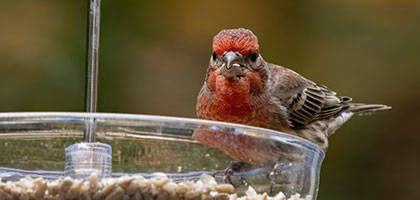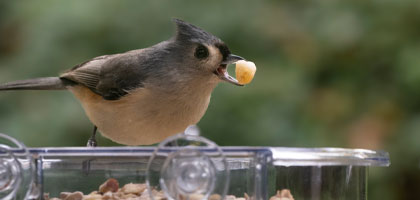Nyjer seed, a favorite among finches and other small birds, is a staple in many bird feeders. But how long does this bird food last before it spoils?
Understanding the shelf life of Nyjer seed is crucial for bird enthusiasts. It ensures the seed you offer is fresh, nutritious, and attractive to your feathered friends.
In this guide, we'll delve into the factors affecting the shelf life of Nyjer seed. We'll also share tips on how to store it properly to maintain its freshness.
Join us as we explore the importance of providing fresh bird food and how to make the most of your Nyjer seed.
What is Nyjer Seed?
Nyjer seed, also known as thistle seed, is a small, black seed cherished by many birds, especially finches. Originating from the highlands of Ethiopia, Nyjer seed is prized for its high oil content.
This tiny seed is packed with essential nutrients, making it an important part of many birds' diets. Its popularity has grown due to its ability to attract vibrant species like goldfinches, siskins, and redpolls to backyards. This seed is not only nutritious but also non-germinating, ensuring your garden stays tidy.
The Importance of Fresh Bird Food
Providing fresh bird food is crucial for attracting and nourishing birds. When bird seed is fresh, it retains its nutritional value, helping birds maintain their health and energy.
Spoiled bird food can deter birds from visiting feeders and may even pose health risks. By ensuring the freshness of the seeds, you can create a more appealing environment for birds, enhancing your bird-watching experience. Fresh food not only attracts more birds but also supports their well-being, particularly during challenging seasons.
Factors Affecting Nyjer Seed Shelf Life
Several factors influence the shelf life of Nyjer seed. Understanding these factors can help you maintain seed freshness and quality. Proper storage conditions are essential in preserving the seed's nutritional value.
Key Factors Include:
- Moisture: High moisture levels can lead to mold and spoilage.
- Temperature: Store seeds in a cool environment to prolong freshness.
- Light Exposure: Excessive light can degrade seed quality.
- Air Exposure: Airtight containers minimize oxidation and pest infestation.
Monitoring these factors helps in maximizing the use of Nyjer seed as bird food. A cool, dry place significantly enhances its shelf life. Consider your local climate to decide the best storage method. Consistent vigilance ensures that the seed remains suitable and nutritious for birds.
Signs of Spoiled Nyjer Seed
Recognizing spoiled Nyjer seed is crucial for bird health. Subtle changes can indicate that the seed is no longer fresh. Identifying these signs early can prevent feeding birds harmful food.
Warning Signs to Look For:
- Mold Growth: Visible mold indicates moisture and spoilage.
- Rancid Odor: A strong, unpleasant smell suggests the seed has gone bad.
- Clumping: Moisture can cause seeds to clump together.
- Discoloration: Changes in seed color can be a sign of aging or spoilage.
If you notice any of these signs, it's best to replace the Nyjer seed immediately. Feeding spoiled seed can discourage birds from visiting and harm their health. Always inspect seed before placing it in feeders to ensure it remains safe and palatable for your feathered visitors.
Best Practices for Storing Nyjer Seed
Proper storage is key to maintaining the freshness of Nyjer seed. Understanding the right methods can help extend its shelf life significantly. It's all about creating the ideal conditions for storage.
Recommended Storage Tips:
- Cool, Dry Place: Store in a location free from excess heat and moisture.
- Airtight Containers: Use to prevent air and pests from contaminating the seed.
- Label and Date: Keep track of when the seed was stored to monitor freshness.
Avoid placing Nyjer seed in direct sunlight, as it can speed up spoilage. The oils in Nyjer seed are sensitive to heat and light, which can degrade its quality.
Additionally, consider buying seed in smaller quantities if you cannot consume large amounts quickly. This reduces the risk of the seed going bad before you can use it.
Using a rotation system in feeders can also help. Avoid overfilling them to ensure that the seed used remains fresh throughout its use. This not only keeps the bird food fresh but also minimizes waste, benefiting both you and the birds.
How to Extend the Shelf Life of Nyjer Seed
Maximizing the longevity of Nyjer seed requires strategic storage practices. Each step in the process plays a vital role in preserving freshness.
Ways to Prolong Freshness:
- Freezing: Place Nyjer seed in airtight bags or containers, then freeze for longer-term storage.
- Avoid Moisture: Ensure containers are completely dry before storing seed to prevent mold.
- Purchase Fresh Seed: Always check for recent harvest or packaging dates when buying.
Additionally, consider inspecting seed before usage. Look for pests and remove any compromised seed. This ensures that only the best quality seed makes it to your feeder.
Monitor and rotate your stock regularly. Use the oldest seed first to minimize waste while maintaining optimal freshness. By following these steps, your Nyjer seed will attract more birds and help sustain their diet.
Purchasing Tips: Quality and Quantity
When buying Nyjer seed, quality should be your top priority. Choose seed from reputable suppliers to ensure freshness and nutritional value.
Consider how much you need before making a purchase. Buying in bulk can seem economical, but smaller quantities might be wise if you have a limited number of feeders. This approach helps prevent waste by ensuring you use the seed within its shelf life.
Check the packaging date on the seed before purchasing. Fresher seeds offer better nourishment and attract more birds, providing a vibrant display in your garden.
Regular Maintenance: Cleaning Feeders and Monitoring Seed
Consistent cleaning of bird feeders is vital for bird health and seed freshness. Feeders can become breeding grounds for bacteria if neglected.
Aim to clean your feeders every two weeks or more frequently during damp weather. Use a mild soap solution and rinse thoroughly to remove residue.
Monitoring the condition of the Nyjer seed in your feeders is equally crucial. Replace any seed that appears spoiled or clumps together. Fresh seed ensures happy and returning birds to your yard. Regular checks prevent health issues for your feathered visitors.
The Role of Nyjer Seed in Bird Nutrition
Nyjer seed is rich in essential oils and protein, crucial for small birds' diets. These nutrients are especially important during colder months when energy needs increase.
Birds like goldfinches and siskins thrive on Nyjer seed, using its high oil content to fuel their flights. Offering Nyjer seed supports their health, enhancing their natural beauty and vitality. Providing diverse food options, including Nyjer seed, fosters a balanced diet for your feathered friends.
FAQs on Nyjer Seed Shelf Life and Storage
Many people ask how long Nyjer seed lasts once opened. Typically, it remains fresh for about 6 to 12 months if stored properly.
An important question is how to recognize when the seed has spoiled. Look for mold, rancid smells, and any visible pests. Storing Nyjer seed in airtight containers is essential to maintain freshness.
Here are some common FAQs:
- How should I store Nyjer seed? Keep it in a cool, dry place using airtight containers.
- Can Nyjer seed be frozen? Yes, freezing can extend its freshness.
- What signs indicate spoilage? Watch for clumping, odors, and discoloration.
Conclusion
Providing fresh Nyjer seed is key to attracting vibrant birdlife to your garden. By understanding proper storage and recognizing spoilage, you ensure a safe food source for birds.
Remember, maintaining the freshness of bird food contributes significantly to their well-being. Happy and healthy birds enhance your bird-watching experiences.




